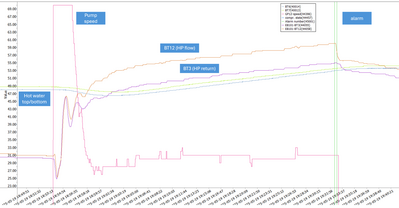Nibe F2040 periodic warm water increase fails
Hi all,
I recently bought a house and am now a proud owner of a Nibe F2040 Heatpump with SMO20 controller. I observed that after each periodic warm water increase a warning appears on the controller, stating that the desired temperature cannot be reached. The maximum temperature which is reached after ~30 min is 54 °C (independently of setting the desired temperature to default 55 °C or 60 °C). When someone inspecting the heating installation came to the house in February, he speculated that the temperature could not be reached due to too cold temperatures. However, since then the warning is still occurring on every try of a periodic heating increase (2 weeks).
I logged temperatures on the SMO20 via USB while doing another unsuccessful hot periodic increase for finding out more and would like to ask for your experienced view on what might be wrong:
I observe that once the periodic increase is initiated at ~18:53, the pump starts running at 70 % and the heatpump starts working with a visible increase in BT3 & BT12. Similarly, the water temperature is also increasing. At 18:57 the pump speed drops to ~30 %. At 19:32 there is a sudden stop in BT12 increase, correlating with triggering of the alarm 162. The alarm indicates that "Condensor out has reached max permitted temperature" and does an automatic reset of the heatpump. From there on it's understandable that the warm water temperature is not increasing anymore, not reaching the target of 55/60 °C.
I have plenty of questions and am grateful for any ideas and opinions:
- How can I solve this issue or is this an issue at all?
- Would increasing the pump speed help in flattening the increase in BT12 such that the limit of 60 °C is reached later, allowing the warm water to heat up to the desired temperature?
- why is the pump speed suddenly dropping?
- If the alarm limit is at 60 °C, then it will never be possible to reach a periodic hot water temperature of 65 °C, which is also an option that can be set on the controller. I think I'm missing something here. Could it be that high temperatures can only be reached with the additional heater?
- regarding the additional heater: as the outside temperatures are ~ 20 °C, the additional heater is not active. Should it be active? Is there a way to activate it only for the periodic hot water increase?
Thanks a lot for all your help!
Many people with heat pumps heat water only to say 48 with a weekly legionella cycle (often using the immersion) taking it to 60/65. This should all be set up on the controller (look for a setting for legionella or disinfection). Heating to 60 every day significantly decrease efficiency and in most cases adds no utility. You only need about 40C at the tap, any more feels too hot.
Depending on your dhw cylinder and spec of the heat pump 55 or 60 may well be unachievable. It's certainly not desirable in most cases so unless there is a good reason to do otherwise I would eliminate the error and save yourself some money by reducing the set temperature to 48.
I could go into more detail but if the obvious answer is ok that's in short the best way forward.
4kW peak of solar PV since 2011; EV and a 1930s house which has been partially renovated to improve its efficiency. 7kW Vaillant heat pump.
I think the NIBE uses both the ASHP and the element to reach the desired temperature, you need to make sure the element portion is working, you could have a defective element.
Periodic High-Temperature Cycles
NIBE systems feature a "periodic increase" function, which periodically raises the hot water temperature to prevent bacterial growth, such as Legionella. During these cycles, the system may activate the immersion heater to reach the necessary higher temperatures. Users can configure the frequency and temperature settings for these cycles through the system's control interface
AAC Group Ltd covering the Kent Area for design, supply and installation of ASHP systems, service and maintenance, diagnostics and repairs.
Professional installer. Book a one-to-one consultation for pre- and post-installation advice, troubleshooting and system optimisation.
Hi, thanks a lot for your answers!
To clarify: with 'periodic warm water increase' I actually refer to the legionella/desinfection mode running every 14 days, I do not plan to keep the warm water temperature at that level.
Alright, so it might be that the system is not designed for the heatpump to heat the water to 60 °C and the immersion heater (VB2210) should help in that case. But as far as I understand: the immersion heater is connected to the SMO20 as additional heater. Due to the current outside temperatures, the additional heater is not active (set to blocked on the controller). -> Do I need to disable any blocking of the additional heater? Actually I would like the additional heater to be only active when needed for the periodic increase and not any other time.
When would the immersion heater be active, is following understanding correct: The heatpump tries to heat up the water until the alarm limit at 60 °C. After failing, the immersion heater takes over until the desired water temperature is reached. Or is the immersion heater directly active from the beginning, supporting the heating?
Thanks a lot!
Ok. The key point I think you have made is that the error only occurs only during the disinfection cycle.
That's getting quite deep into NIBE specific matters, IE how exactly the NIBE controller works. It probably needs a NIBE expert/owner to answer that. You could have a poke around in the settings/installer manual to see if anything pops up.
I apologise that I can't be more helpful on this occasion.
4kW peak of solar PV since 2011; EV and a 1930s house which has been partially renovated to improve its efficiency. 7kW Vaillant heat pump.
@tribol welcome to the forums.
I’m just spitballing here, but from what you’ve described, it sounds like your system is hitting its BT12 (condenser out) temperature limit, which is what’s triggering the alarm 162 and shutting down the heat pump during the legionella cycle. This can point to insufficient heat dissipation… basically, the unit is generating heat faster than it can shift it into the hot water cylinder. That’s why BT12 climbs too high and the system trips out before hitting your DHW setpoint.
In theory, increasing the pump speed (more water circulating faster through the cylinder coil) can help by drawing heat away from the heat pump more effectively. If the pump slows down early in the cycle that could explain why BT12 starts to spike… the heat has nowhere to go.
I’ll flag this post with NIBE and see if they can help.
In terms of legionella related risks, here’s some additional reading: https://renewableheatinghub.co.uk/legionnaires-disease-home-hot-water-understanding-risks-and-prevention/
Get a copy of The Ultimate Guide to Heat Pumps
Subscribe and follow our YouTube channel!
@tribol here's an official reply from NIBE on your case:
"Your legionella program is set to run on a weekly basis and will take your cylinder up to the default preset temperature of 55.0 degC and maintain it for a period of one hour, this will satisfy the legionella program. In your case the legionella program is failing because you aren’t reaching the default temperature of 55.0 on the hot water sensor BT6.
The legionella program will first use the heat pump but will then automatically switch over to the immersion within the HW cylinder for the last few degrees of input until the default setting is achieved. If your HW immersion isn’t coming on, then this could be the reason for the issue you are having.
You should have a device called an HR10 (square grey box) on the front of the box is a rocker switch with on/off/auto, make sure this switch is set to “Auto” and you HW immersion has a live power supply. The best way to get help and advice from NIBE is to contact Homeowner Care on 0330 311 2201."
Get a copy of The Ultimate Guide to Heat Pumps
Subscribe and follow our YouTube channel!
-
Sudden drop in COP
5 months ago
-
Running my new Nibe ASHP efficiently
11 months ago
-
Heat Pump, DHW, UFH and Radiator Install
1 year ago
-
Mitsubishi Ecodan - Hot Water Settings
2 years ago
-
DHW via Weather Compensation (Daiken Weather Dependent)
3 years ago
- 26 Forums
- 2,357 Topics
- 53.5 K Posts
- 270 Online
- 6,025 Members
Join Us!
Worth Watching
Latest Posts
-

RE: Speedcomfort radiator fans
My take on Speedcomfort radiator fans: If anyone w...
By Mars , 1 minute ago
-
RE: Midea ASHP – how to set weather compensation
@pash44pump I have yet to come across any Clivet or Mid...
By benson , 29 minutes ago
-
RE: Who's your electricity provider and what's your tariff?
@transparent Thanks, this helps. Could it be that St...
By Batpred , 53 minutes ago
-
RE: Clivet ASHPs and weather compensation
Simon did share a lot of very helpful advice. On furthe...
By ambris , 58 minutes ago
-
My Powerwall 3 Consumes 3-4 kWh/Day in Self-Consumption: Is This Normal?
I had solar panels & Powerwall 3 installed in Augus...
By Caron , 2 hours ago
-
-
MyVaillant Connect Regular Disconnect
A couple of weeks ago the MyVaillant Controller had a r...
By buckwem , 13 hours ago
-

RE: Setback savings - fact or fiction?
I could, but I think we can do better, by plotting hour...
By cathodeRay , 18 hours ago
-
RE: Advice on internal circulation pump noise
Extend the primary branch and make sure you have more t...
By ASHP-BOBBA , 21 hours ago
-

RE: External pipework insulation
Oh Dear! that's appalling pipe work, should've been in ...
By dgclimatecontrol , 1 day ago
-

RE: Jokes and fun posts about heat pumps and renewables
By Morgan , 1 day ago
-

RE: Controlling Daikin Altherma via P1P2 and Home Assistant
On the contrary, @toodles, that’s a lot of help. I’d ne...
By Majordennisbloodnok , 1 day ago
-
RE: Octopus Cosy Heat Pump Owners & Discussion Thread
@kevh with the Cosy 6 I know it definitely goes to arou...
By HarrisonC , 2 days ago
-

Parsnip, Bacon & Coconut Milk Soup
First let me say, I am only a cook because I am human a...
By Toodles , 2 days ago
-
RE: Electricity price predictions
Ben Watts posted on LinkedIn that he had updated this w...
By Judith , 2 days ago
-

RE: The good, the bad and the not that great – my heat pump installation
Small update, Emailed and Spoke to Midea UK and they ...
By Burtis , 2 days ago
-
RE: Solis S6-EH1P8K-L-PLUS – Why I Chose It and What I’ve Learned So Far
@bash Octopus does charge for the admin. The process al...
By Batpred , 2 days ago
-
RE: New Fogstar 15.5kWh upright solution
Issues still under investigation by Solis... Fogstar ...
By Batpred , 2 days ago






